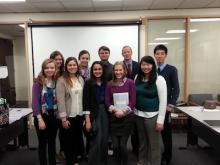In the midst of winter quarter finals, 10 LSJ honors students presented their work at Columbia Legal Services in downtown Seattle. Their presentation, delivered on March 19, covered the research the group conducted over two quarters about the holding of juveniles in adult jails in Washington State.
Their report, “Guilty but Innocent: Juveniles in Jail in Washington State,” addressed the issues surrounding holding youth—that is, people between the age of 15 and 18—in facilities usually reserved for adults. These issues included access to education, the disciplinary method of isolation, and the implications of holding the youth in jails instead of more juvenile-oriented facilities.
The project was the core of the LSJ 489 Honors class led by Professor Steve Herbert during autumn and winter quarters. This is the second time this course has been taught as a group project.
Going in, the issue of young people being held in adult jails in the state of Washington was not a topic about which any of the group knew anything.
“When Columbia Legal Services initially presented this to us, none of us had any familiarity with this at all,” said Martha Muldowney, a senior. “As soon as we started a broad area of research, we realized that there wasn’t a lot of information about this available. We were pretty much creating a whole new dataset from scratch, which was somewhat overwhelming.”
Throughout their research, the 10 students visited five of the detention facilities in person, made phone calls, sent countless emails to county staff across the state and, in some cases, even spoke to young inmates in person or over the phone.
When the group started in autumn quarter, there was some uncertainty in what the group was even doing.
“In the beginning we all had different presumptions about what we were going to expect,” said Anu Sidhu, a junior. “We had a hypothesis, but as we gathered more and more data, we found that hypothesis wasn’t necessarily true. There were things that we didn’t consider.”
Among their key findings were that the number of juveniles in jail has declined by about 50 percent between 2009 and 2012, and that the average length of stay for juveniles in jail was about 140 days, or 4.7 months.
To look beyond these numbers, the group was able to interview a group of juveniles being held at Green Hill School in Chehalis, one of four Juvenile Rehabilitation Administration (JRA) facilities in Washington. These were youth who had previously spent time in an adult jail while their cases were being adjudicated. To the group’s surprise, most of the Green Hill youth expressed an appreciation for being with their older counterparts.
The age ranges of the different facilities could account for part of this appreciation; in their report, the group wrote that “the levels of maturity and respect [in the juvenile detention centers] were lower than in jail.” Many of the inmates felt patronized by the staff in the juvenile centers. On top of this, they reported that some of the youth in the jails felt that having the mentorship of older inmates with similar experiences was beneficial for their growth and their future intent “to avoid becoming trapped in the system.”
The group became intimate with the system, and one member even asserted that if anyone were to speak to him about the topic, they had better know what they were talking about.
For his part, Professor Herbert was stunned by how hard the group worked in gathering its data and in cohering as a group.
“This course posed a very difficult challenge: to gather and analyze a sizable amount of data, and to work cooperatively in doing so,” he said. “I cannot imagine a group of students performing these tasks better than this group did.”
Marc Meyer, a senior, had learned the topic for the honors class at the beginning of summer. When he embarked on his study abroad trip in Amsterdam a couple months later, he studied the juvenile detention system internationally to get a feel for what he was about to get into with his group.
Though it was challenging in that the group had to get almost all of their information via their own leg- and phone-work, it turned out to be a rewarding project overall for the students.
“The reason I came to college was for experiences like this,” said Meyer, who sported a bow tie for the presentation. “I feel like this is the class that I was hoping for in college: something where you can try out what you want to do.”
You can find a PDF of the group’s report online here.
A video of the presentation was recorded, which can be seen in a YouTube playlist here.
This article was composed by Kristine Kim.
